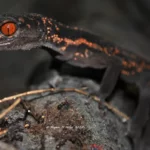Hey there, wildlife enthusiasts! Buckle up for an adventure to the Ryukyu Islands of Japan, home to the elusive Tokashiki gecko, also known as Kuroiwa’s ground gecko or the Ryukyu eyelid gecko. These fascinating reptiles, scientifically known as Goniurosaurus kuroiwae, are shrouded in mystery, but we’re here to unveil their secrets. Join us as we delve into their unique characteristics, explore their preferred habitat, uncover their diet, and understand the challenges they face as an endangered species.
Tokashiki Gecko Facts: A Glimpse into a Unique Species
The Tokashiki gecko stands out as a remarkable reptile found exclusively in Okinawa Prefecture, Japan. These geckos are highly specialized, preferring the humid embrace of subtropical forests below 450 meters (1,480 feet) in elevation. Their ideal niche lies within the karst limestone areas, where they navigate the forest floor as nocturnal predators. When the sun sets, they emerge from their hiding places to hunt for small invertebrates concealed within the leaf litter.
Curious about whether the kuroiwa ground gecko is nocturnal or dimural? Then, click here. Meanwhile, you’ll be surprised with the kuroiwa ground gecko’s description and size.
Interestingly, the scientific name kuroiwae pays homage to T. Kuroiwa, the first scientist to collect a specimen of this species. The Tokashiki gecko holds yet another intriguing fact: it can carry a tiny parasite called Cryptosporidium serpentis, which, fortunately, only affects reptiles.
Kuroiwa’s Ground Gecko: A Closer Look at an Endangered Species
Kuroiwa’s ground gecko faces significant threats, primarily due to habitat loss and fragmentation driven by human activities. Imagine your neighborhood being bulldozed – that’s the reality these geckos face as their forest homes disappear. This severe habitat loss has earned them a ‘vulnerable’ conservation status, meaning they are at risk of becoming endangered. The situation is even more dire for two subspecies, the sengokui and toyamai, which are critically endangered – just one step away from disappearing from the planet altogether.
These nocturnal marvels spend their days concealed, only emerging at night to hunt. While their appearance might seem intimidating, they are harmless to humans, despite old rumors claiming they were poisonous.
Efforts to protect these amazing creatures are underway. Conservationists are diligently working to restore their natural habitats, creating safe havens where they can thrive. Breeding programs are also being implemented to bolster their dwindling populations.
Where Does Kuroiwa’s Ground Gecko Live? Exploring its Habitat
Imagine venturing into a lush subtropical forest, the air thick with humidity. As you navigate through dense foliage and towering trees, you find yourself in the heart of the Kuroiwa’s ground gecko’s domain. These geckos favor lower elevations, rarely venturing above 450 meters, where the forest floor provides ample cover and a humid environment.
These elusive creatures are creatures of the night, preferring the cool darkness to the heat of the day. They are highly adapted to life on the forest floor, particularly in areas rich in karst limestone formations. However, this specialized lifestyle makes them particularly vulnerable to habitat loss, a pressing concern that threatens their survival.
What Does Kuroiwa’s Ground Gecko Eat? Uncovering its Diet
The Kuroiwa’s ground gecko is a fascinating example of a specialized insectivore. While they are not particularly picky eaters, beetles and moths constitute a significant portion of their diet. These geckos employ a patient “sit-and-wait” hunting strategy, relying on stealth and camouflage to ambush unsuspecting prey. They will remain motionless for extended periods, blending seamlessly with their surroundings until an insect wanders within striking distance.
Interestingly, female Kuroiwa’s ground geckos tend to have higher feeding frequencies compared to their male counterparts. Researchers believe this difference might be attributed to the energy demands of the females’ reproductive cycle, particularly egg production.
The Importance of Understanding Their Diet:
Gaining insights into the Kuroiwa’s ground gecko’s diet is crucial for their conservation. Ensuring a healthy and abundant population of their preferred insect prey within their natural habitat is essential for the long-term survival of this unique gecko species.
Protecting the Tokashiki Gecko:
Understanding the Tokashiki gecko’s unique characteristics, habitat preferences, and dietary needs is essential for effective conservation efforts. Protecting their remaining habitat, mitigating the impacts of habitat loss and fragmentation, and ensuring a thriving insect population are crucial steps towards safeguarding these incredible creatures for generations to come.
- Unveiling Bernhard Caesar Einstein’s Scientific Achievements: A Legacy in Engineering - July 15, 2025
- Uncover who is Jerry McSorley: CEO, Family Man, Business Success Story - July 15, 2025
- Discover Bernhard Caesar Einstein’s Scientific Contributions: Unveiling a Legacy Beyond Einstein - July 15, 2025
















Comments are closed.